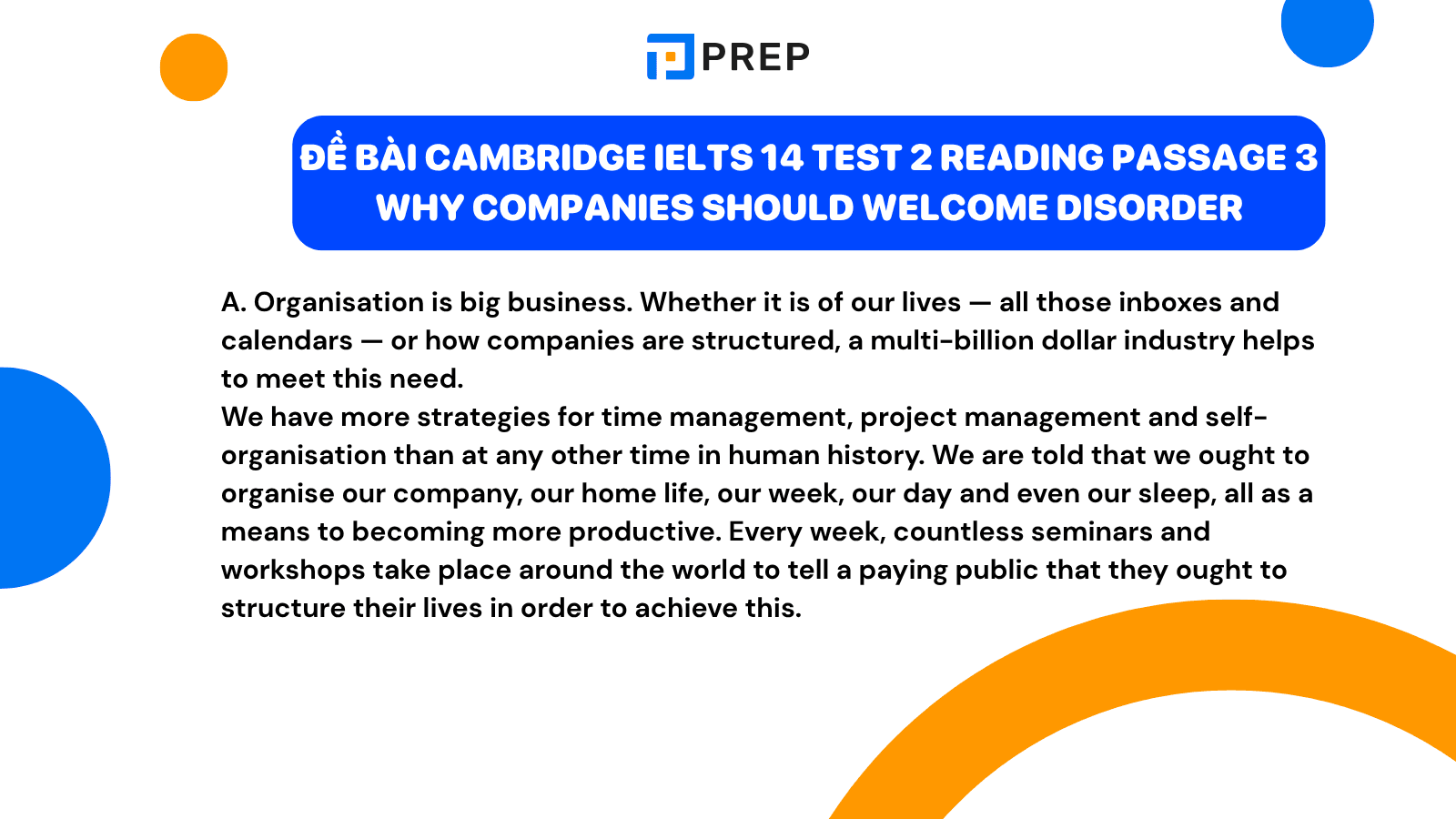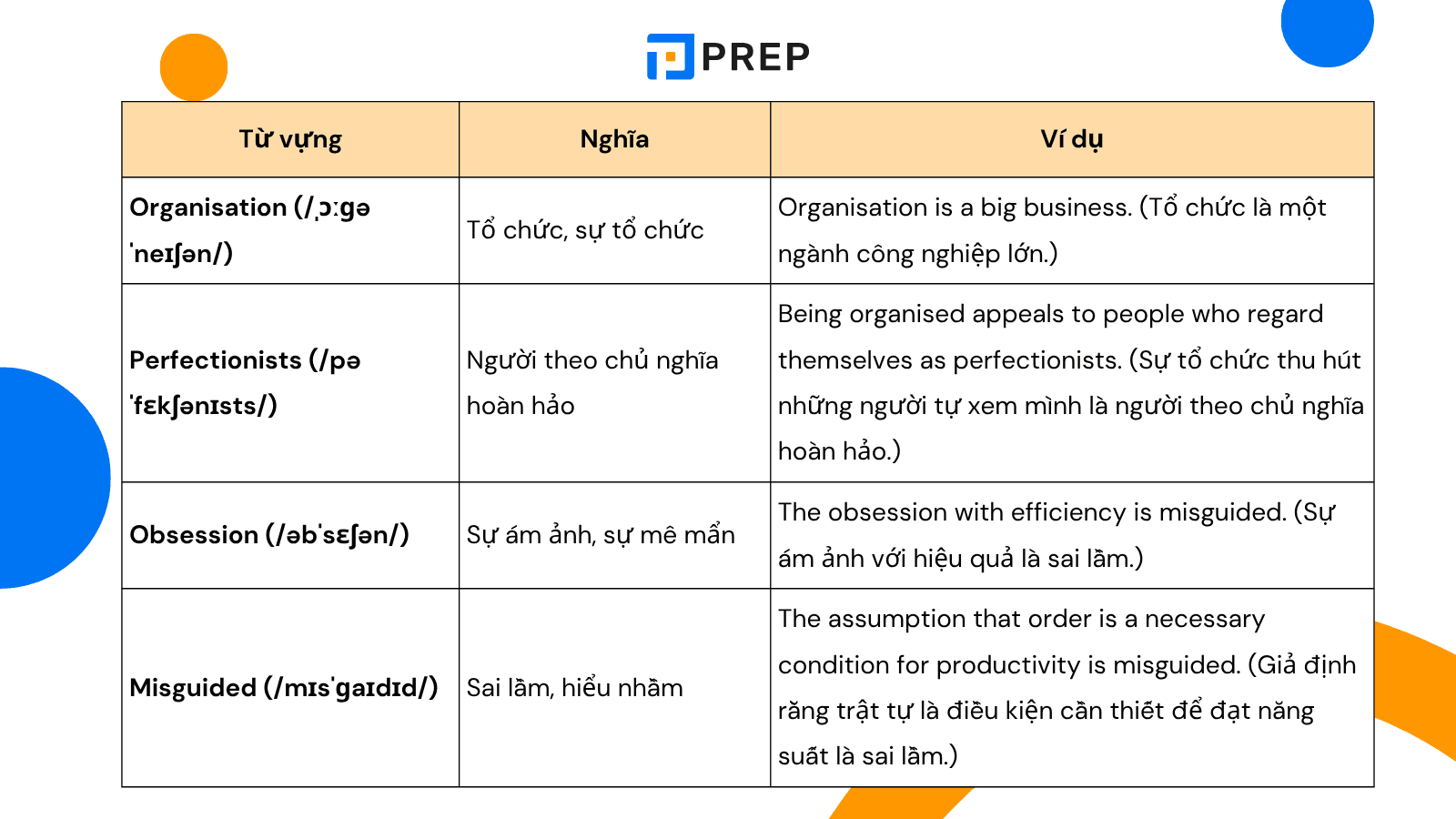Đề bài và đáp án đề Cambridge IELTS 14 Test 2 Reading passage 3 Why companies should welcome disorder
Bài đọc “Why companies should welcome disorder” trong Cambridge IELTS 14 Test 2 Reading Passage 3 bàn về một chủ đề thú vị trong lĩnh vực quản trị và sáng tạo - “hỗn loạn có tổ chức” (constructive disorder). Đây là chủ đề bài đọc khá khó và mới. Dưới đây là đề bài, đáp án chi tiết bài đọc Why companies should welcome disorder, cùng tham khảo để luyện tập hiệu quả hơn nhé!

I. Đề bài đọc Cambridge IELTS 14 Test 2 Reading Passage 3 Why companies should welcome disorder
Reading Why companies should welcome disorder
Why companies should welcome disorder
A. Organisation is big business. Whether it is of our lives — all those inboxes and calendars — or how companies are structured, a multi-billion dollar industry helps to meet this need.
We have more strategies for time management, project management and self-organisation than at any other time in human history. We are told that we ought to organise our company, our home life, our week, our day and even our sleep, all as a means to becoming more productive. Every week, countless seminars and workshops take place around the world to tell a paying public that they ought to structure their lives in order to achieve this.
This rhetoric has also crept into the thinking of business leaders and entrepreneurs, much to the delight of self-proclaimed perfectionists with the need to get everything right. The number of business schools and graduates has massively increased over the past 50 years, essentially teaching people how to organise well.
B. Ironically, however, the number of businesses that fail has also steadily increased. Work-related stress has increased. A large proportion of workers from all demographics claim to be dissatisfied with the way their work is structured and the way they are managed.
This begs the question: what has gone wrong? Why is it that on paper the drive for organisation seems a sure shot for increasing productivity, but in reality falls well short of what is expected?
C. This has been a problem for a while now. Frederick Taylor was one of the forefathers of scientific management. Writing in the first half of the 20th century, he designed a number of principles to improve the efficiency of the work process, which have since become widespread in modern companies. So the approach has been around for a while.
D. New research suggests that this obsession with efficiency is misguided. The problem is not necessarily the management theories or strategies we use to organise our work; it’s the basic assumptions we hold in approaching how we work. Here it’s the assumption that order is a necessary condition for productivity. This assumption has also fostered the idea that disorder must be detrimental to organisational productivity. The result is that businesses and people spend time and money organising themselves for the sake of organising, rather than actually looking at the end goal and usefulness of such an effort.
E. What’s more, recent studies show that order actually has diminishing returns. Order does increase productivity to a certain extent, but eventually the usefulness of the process of organisation, and the benefit it yields, reduce until the point where any further increase in order reduces productivity. Some argue that in a business, if the cost of formally structuring something outweighs the benefit of doing it, then that thing ought not to be formally structured. Instead, the resources involved can be better used elsewhere.
F. In fact, research shows that, when innovating, the best approach is to create an environment devoid of structure and hierarchy and enable everyone involved to engage as one organic group. These environments can lead to new solutions that, under conventionally structured environments (filled with bottlenecks in terms of information flow, power structures, rules, and routines) would never be reached.
G. In recent times companies have slowly started to embrace this disorganisation. Many of them embrace it in terms of perception (embracing the idea of disorder, as opposed to fearing it) and in terms of process (putting mechanisms in place to reduce structure).
For example, Oticon, a large Danish manufacturer of hearing aids, used what it called a ‘spaghetti’ structure in order to reduce the organisation's rigid hierarchies. This involved scrapping formal job titles and giving staff huge amounts of ownership over their own time and projects. This approach proved to be highly successful initially, with clear improvements in worker productivity in all facets of the business.
In similar fashion, the former chairman of General Electric embraced disorganisation, putting forward the idea of the ‘boundaryless’ organisation. Again, it involves breaking down the barriers between different parts of a company and encouraging virtual collaboration and flexible working. Google and a number of other tech companies have embraced (at least in part) these kinds of flexible structures, facilitated by technology and strong company values which glue people together.
H. A word of warning to others thinking of jumping on this bandwagon: the evidence so far suggests disorder, much like order, also seems to have diminishing utility, and can also have detrimental effects on performance if overused. Like order, disorder should be embraced only so far as it is useful. But we should not fear it – nor venerate one over the other. This research also shows that we should continually question whether or not our existing assumptions work.
Questions 27-34
Reading Passage 3 has eight sections, A-H.
Choose the correct heading for each section from the list of headings below.
Write the correct number, i-ix, in boxes 27-34 on your answer sheet.
List of Headings
i. Complaints about the impact of a certain approach
ii. Fundamental beliefs that are in fact incorrect
iii. Early recommendations concerning business activities
iv. Organisations that put a new approach into practice
v. Companies that have suffered from changing their approach
vi. What people are increasingly expected to do
vii. How to achieve outcomes that are currently impossible
viii. Neither approach guarantees continuous improvement
ix. Evidence that a certain approach can have more disadvantages than advantages
-
Section A ........................
-
Section B ........................
-
Section C ........................
-
Section D ........................
-
Section E ........................
-
Section F ........................
-
Section G ........................
-
Section H ........................
Questions 35-37
Complete the sentences below.
Choose ONE WORD ONLY from the passage for each answer.
Write your answers in boxes 35-37 on your answer sheet.
-
Numerous training sessions are aimed at people who feel they are not ______________________ enough.
-
Being organised appeals to people who regard themselves as ______________________.
-
Many people feel ______________________ with aspects of their work.
Questions 38-40
Do the following statements agree with the information given in Reading Passage 3?
In boxes 38-40 on your answer sheet, write
-
TRUE if the statement agrees with the information
-
FALSE if the statement contradicts the information
-
NOT GIVEN if there is no information on this
-
Both businesses and people aim at order without really considering its value. ........................
-
Innovation is most successful if the people involved have distinct roles. ........................
-
Google was inspired to adopt flexibility by the success of General Electric. ........................

II. Đáp án bài đọc Why companies should welcome disorder
Tham khảo why companies should welcome disorder answers:
-
vi
-
i
-
iii
-
ii
-
ix
-
vii
-
iv
-
viii
-
productive
-
perfectionists
-
dissatisfied
-
TRUE
-
FALSE
-
NOT GIVEN
III. Giải thích đáp án chi tiết
Tham khảo phần giải thích chi tiết đáp án cho bài Reading Passage 3 trong Cambridge IELTS 14, Test 2: "Why companies should welcome disorder".
Questions 27-34
Question 27:
-
Đáp án: vi
-
Vị trí: Đoạn A.
-
Giải thích: Đoạn A nói về việc con người đang ngày càng có nhiều phương pháp để quản lý thời gian, dự án và tự tổ chức bản thân hơn bao giờ hết. Điều này phản ánh việc con người “ngày càng được kỳ vọng phải tổ chức công ty, cuộc sống cá nhân, tuần, ngày và thậm chí giấc ngủ” để trở nên năng suất hơn. Vì vậy, đáp án là “vi”.
Question 28:
-
Đáp án: i
-
Vị trí: Đoạn B.
-
Giải thích: Đoạn B đề cập đến các phàn nàn của mọi người về ảnh hưởng tiêu cực của việc tổ chức công việc. Những người làm việc cảm thấy không hài lòng với cách công việc của họ được tổ chức và quản lý. Vì vậy, đáp án là “i” (Complaints about the impact of a certain approach).
Question 29:
-
Đáp án: iii
-
Vị trí: Đoạn C.
-
Giải thích: Đoạn C nhắc đến Frederick Taylor, một trong những người đầu tiên đề xuất các nguyên lý quản lý khoa học để cải thiện hiệu quả công việc. Những nguyên lý này đã trở thành một phần quan trọng trong các công ty hiện đại. Vì vậy, đáp án là “iii” (Early recommendations concerning business activities).
Question 30:
-
Đáp án: ii
-
Vị trí: Đoạn D.
-
Giải thích: Đoạn D đề cập đến giả định cơ bản sai lầm rằng "trật tự là điều kiện cần thiết để đạt năng suất". Đây là những giả định sai lầm cần phải được nhìn nhận lại. Vì vậy, đáp án là “ii” (Fundamental beliefs that are in fact incorrect).
Question 31:
-
Đáp án: ix
-
Vị trí: Đoạn E.
-
Giải thích: Đoạn E chỉ ra rằng mặc dù trật tự có thể giúp tăng năng suất một phần, nhưng nếu cố gắng tăng cường tổ chức quá mức, kết quả sẽ giảm sút. Vì vậy, đáp án là “ix” (Evidence that a certain approach can have more disadvantages than advantages).
Question 32:
-
Đáp án: vii
-
Vị trí: Đoạn F.
-
Giải thích: Đoạn F nói về việc tạo ra một môi trường không có cấu trúc và phân cấp để thúc đẩy sự sáng tạo và đổi mới, điều mà hiện tại chưa được thực hiện trong các công ty truyền thống. Vì vậy, đáp án là “vii” (How to achieve outcomes that are currently impossible).
Question 33:
-
Đáp án: iv
-
Vị trí: Đoạn G.
-
Giải thích: Đoạn G đưa ra các ví dụ về các công ty như Oticon và General Electric đã áp dụng phương pháp không cấu trúc để đạt được kết quả tích cực. Vì vậy, đáp án là “iv” (Organisations that put a new approach into practice).
Question 34:
-
Đáp án: viii
-
Vị trí: Đoạn H.
-
Giải thích: Đoạn H cảnh báo rằng mặc dù sự hỗn loạn (disorder) có thể có lợi, nếu lạm dụng quá mức thì nó cũng sẽ giảm dần hiệu quả và có thể gây hại. Do đó, như trật tự, hỗn loạn cần được sử dụng một cách có giới hạn. Vì vậy, đáp án là “viii” (Neither approach guarantees continuous improvement).
Questions 35-37
Question 35:
-
Đáp án: productive
-
Vị trí: Đoạn A.
-
Giải thích: Đáp án cần tìm là một tính từ để hoàn thành câu "cảm thấy chưa đủ ____". Câu hỏi liên quan đến những người tham gia các khóa đào tạo để trở nên năng suất hơn. Vì vậy, đáp án là “productive”.
Question 36:
-
Đáp án: perfectionists
-
Vị trí: Đoạn A.
-
Giải thích: Đoạn A đề cập đến những người có xu hướng tự xưng là “perfectionists” (người theo chủ nghĩa hoàn hảo), những người tìm kiếm sự tổ chức trong công việc và cuộc sống của mình. Vì vậy, đáp án là “perfectionists”.
Question 37:
-
Đáp án: dissatisfied
-
Vị trí: Đoạn B.
-
Giải thích: Đoạn B nói rằng nhiều người cảm thấy “dissatisfied” (không hài lòng) với cách công việc của họ được tổ chức. Vì vậy, đáp án là “dissatisfied”.
Questions 38-40
Question 38:
-
Đáp án: TRUE
-
Vị trí: Đoạn D.
-
Giải thích: Đoạn D nói rằng các công ty và cá nhân đã chi thời gian và tiền bạc cho việc tổ chức công việc mà không thực sự đánh giá mục tiêu cuối cùng và lợi ích của những nỗ lực đó. Vì vậy, đáp án là “TRUE”.
Question 39:
-
Đáp án: FALSE
-
Vị trí: Đoạn F.
-
Giải thích: Đoạn F chỉ ra rằng sự đổi mới là hiệu quả nhất trong một môi trường không có cấu trúc và phân cấp, không phải trong môi trường có vai trò phân biệt rõ ràng. Vì vậy, đáp án là “FALSE”.
Question 40:
-
Đáp án: NOT GIVEN
-
Vị trí: Đoạn G.
-
Giải thích: Đoạn G chỉ nói rằng General Electric đã áp dụng một phương pháp không có cấu trúc, nhưng không nói rõ ràng Google lấy cảm hứng từ họ. Vì vậy, đáp án là “NOT GIVEN”.
IV. Từ vựng hay trong bài cần ghi nhớ
Dưới đây là tổng hợp một số từ vựng hay trong bài đọc Why companies should welcome disorder mà bạn nên ghi nhớ. Cùng Prep lưu lại nhé!
|
Từ vựng |
Nghĩa |
Ví dụ |
|
Organisation (/ˌɔːɡəˈneɪʃən/) |
Tổ chức, sự tổ chức |
Organisation is a big business. (Tổ chức là một ngành công nghiệp lớn.) |
|
Perfectionists (/pəˈfɛkʃənɪsts/) |
Người theo chủ nghĩa hoàn hảo |
Being organised appeals to people who regard themselves as perfectionists. (Sự tổ chức thu hút những người tự xem mình là người theo chủ nghĩa hoàn hảo.) |
|
Obsession (/əbˈsɛʃən/) |
Sự ám ảnh, sự mê mẩn |
The obsession with efficiency is misguided. (Sự ám ảnh với hiệu quả là sai lầm.) |
|
Misguided (/mɪsˈɡaɪdɪd/) |
Sai lầm, hiểu nhầm |
The assumption that order is a necessary condition for productivity is misguided. (Giả định rằng trật tự là điều kiện cần thiết để đạt năng suất là sai lầm.) |
|
Diminishing returns (/dɪˈmɪnɪʃɪŋ rɪˈtɜːnz/) |
Lợi ích giảm dần |
Order has diminishing returns. (Trật tự có lợi ích giảm dần.) |
|
Bottleneck (/ˈbɒtəlnɛk/) |
Vấn đề, điểm nghẽn |
Bottlenecks in terms of information flow. (Những điểm nghẽn trong dòng chảy thông tin.) |
|
Hierarchy (/ˈhaɪərɑːki/) |
Cấu trúc phân cấp |
The company removed its rigid hierarchy. (Công ty đã loại bỏ cấu trúc phân cấp cứng nhắc của mình.) |
|
Innovating (/ˈɪnəveɪtɪŋ/) |
Đổi mới, sáng tạo |
When innovating, the best approach is to create an environment devoid of structure. (Khi đổi mới, cách tiếp cận tốt nhất là tạo ra một môi trường không có cấu trúc.) |
|
Devoid of (/dɪˈvɔɪd əv/) |
Thiếu, không có |
An environment devoid of structure. (Một môi trường thiếu cấu trúc.) |
|
Boundaryless (/ˈbaʊndərɪləs/) |
Không có biên giới, không có ranh giới |
The boundaryless organisation encourages collaboration. (Tổ chức không biên giới khuyến khích sự hợp tác.) |
|
Flexibility (/ˌflɛksɪˈbɪləti/) |
Tính linh hoạt |
Flexible structures facilitate collaboration. (Cấu trúc linh hoạt tạo điều kiện thuận lợi cho sự hợp tác.) |
|
Hierarchy (/ˈhaɪərɑːki/) |
Cấu trúc phân cấp |
The company's rigid hierarchy was replaced by a more flexible system. (Cấu trúc phân cấp cứng nhắc của công ty đã được thay thế bằng một hệ thống linh hoạt hơn.) |
|
Venerate (/ˈvɛnəreɪt/) |
Tôn sùng, tôn trọng quá mức |
We should not venerate one approach over the other. (Chúng ta không nên tôn sùng một cách tiếp cận hơn cách tiếp cận khác.) |
|
Utility (/juːˈtɪlɪti/) |
Tính hữu ích |
Disorder can have diminishing utility if overused. (Hỗn loạn có thể giảm tính hữu ích nếu bị lạm dụng quá mức.) |
|
Perception (/pəˈsɛpʃən/) |
Nhận thức, cách nhìn nhận |
Embracing the idea of disorder, as opposed to fearing it, can change perception. (Chấp nhận ý tưởng hỗn loạn, thay vì sợ hãi nó, có thể thay đổi nhận thức.) |

Trên đây là đề bài, đáp án chi tiết và một số từ vựng hay trong bài đọc Cambridge IELTS 14 Test 2 Reading Passage Why companies should welcome disorder mà Prep đã tổng hợp. Hy vọng tài liệu trên sẽ hữu ích cho bạn trong quá trình luyện thi IELTS.
Học tiếng Anh online dễ dàng hơn với PREP - Nền tảng Học & Luyện thi thông minh cùng AI. Nhờ công nghệ AI độc quyền, bạn có thể tự học trực tuyến ngay tại nhà, chinh phục lộ trình học IELTS, TOEIC, tiếng Anh giao tiếp hiệu quả. Bên cạnh đó, học viên còn có sự hỗ trợ tuyệt vời từ Teacher Bee AI, trợ lý ảo giúp bạn giải đáp thắc mắc và đồng hành 1-1 trong suốt quá trình học tập. Hãy click TẠI ĐÂY hoặc liên hệ HOTLINE 0931428899 để nhận tư vấn chi tiết về các khóa học tiếng Anh chất lượng nhất thị trường!
Tải ngay app PREP để bắt đầu hành trình học tiếng Anh tại nhà với chương trình học luyện thi online chất lượng cao.

Chào bạn! Mình là Hiền Hoàng, hiện đang đảm nhận vai trò quản trị nội dung sản phẩm tại Blog của website prepedu.com.
Với hơn 5 năm tự học các ngoại ngữ như tiếng Anh, tiếng Trung và ôn luyện một số kỳ thi IELTS, TOEIC, HSK, mình đã tự đúc rút được nhiều kinh nghiệm để hỗ trợ hàng nghìn người đang gặp khó khăn trong việc học ngoại ngữ. Hy vọng rằng những chia sẻ phía trên sẽ giúp ích cho bạn trong quá trình tự ôn luyện thi hiệu quả tại nhà!
Bình luận
Nội dung premium
Xem tất cảLộ trình cá nhân hoá
Có thể bạn quan tâm
Kết nối với Prep

MSDN: 0109817671.
Địa chỉ liên hệ: Tòa nhà Vinaconex, 34 Láng Hạ, phường Láng, TP Hà Nội.
Địa chỉ kinh doanh: Lô 21 C2 Khu đô thị Nam Trung Yên, phường Yên Hòa, TP Hà Nội.
Trụ sở: Số nhà 20, ngách 234/35 đường Hoàng Quốc Việt, phường Nghĩa Đô, TP Hà Nội.
Phòng luyện ảo - Trải nghiệm thực tế - Công nghệ hàng đầu.
Hotline: 0931 42 8899.
Trụ sở: Số nhà 20, ngách 234/35 đường Hoàng Quốc Việt, phường Nghĩa Đô, TP Hà Nội.
Giấy chứng nhận hoạt động đào tạo, bồi dưỡng số 1309/QĐ-SGDĐT ngày 31 tháng 07 năm 2023 do Sở Giáo dục và Đào tạo Hà Nội cấp.























